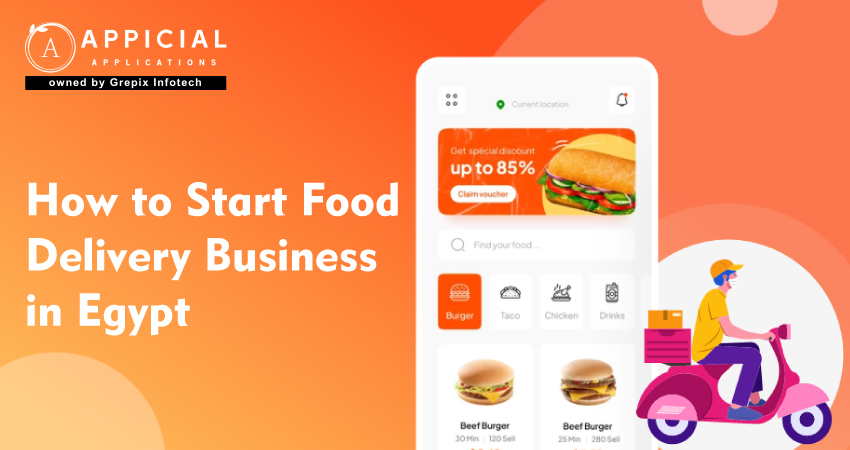
How to Start a Food Delivery Business in Egypt
Egypt is going digital fast.
More people have smartphones. Internet access sits near 72% penetration, with nearly 82 million active users in 2024.
Foodservice and delivery are growing, too. The fast-food sector and quick service dining keep expanding. Restaurants are pushing into the digital world more than ever.
This shift gives a big opening for a local Food Delivery App.
People expect convenience. They want apps they trust. They expect real-time tracking. And they want menu variety.So if you’re thinking of launching a food delivery startup, this is your moment. This blog covers it all: Why invest, features you need, tech stack, challenges, cost, and how to launch with the right development partner.
Egypt’s food delivery scene is booming. The Online Food Delivery App market hits about US$3.9 billion in 2025, and meal delivery alone is growing at over 14% annually. Young, urban populations in Cairo and Alexandria increasingly order via mobile. Platforms like Talabat dominate today, but gaps remain for new entrants. This post walks you through why this market is ready for innovation, the must-have features for your Food Delivery App, how to build it with reliable tech, typical development costs & timeline, and how Appicial Applications, a smart Food App Development Company, can help you launch and scale. It’s your roadmap to enter Egypt’s dynamic Food Delivery Platforms ecosystem.
Why Invest in Food Delivery App Development in Egypt?
1 Large and Growing Market
Egypt’s Online Food Delivery App market is set to reach about US$3.9 billion in 2025, growing at roughly 8.5% per year through 2030. The meal delivery segment alone will grow by over 14% in 2025. The broader foodservice industry is expected to rise at a 14–15% CAGR through 2030.
2 Urban, Young, and Tech-Savvy Population
About 60% of Egyptians are under 30, and most live in urban areas like Cairo, Alexandria, and Giza. They’re comfortable ordering via apps and hungry for variety and convenience.
3 Increasing Smartphone & Payment Access
Mobile internet subscriptions surpassed 106 million by late 2023, and internet penetration rose above 72% in 2024. Payment infrastructure is expanding, too. Wallets, cards, and cash-on-delivery all work online.
4 Demand for New Platforms
Today, Talabat (formerly Otlob) dominates Egypt, and ElMenus remains an option. But many users complain about high fees and limited choices community-wide. That leaves room for fresh Food Delivery Platforms, better pricing, faster service, and more trust.
5 Cloud Kitchens & Restaurant Partnerships
Both big and small restaurants and cloud kitchens are eager to collaborate with delivery platforms in order to increase their reach. You can partner with local kitchens and shadow international chains.
Having said that, these factors make Egypt fertile ground to Create Food Delivery App businesses or Build Food Delivery App brands tailored to local needs.
What are the Must-Have Features for a Food Delivery App?
Your app should feel smooth, reliable, and familiar, think Uber Eats Delivery or Grubhub Delivery level experience, but local.
Customer App:
- Easy sign-up: phone, email, social login
- Browse menus, filter by cuisine, rating, price
- Real-time order tracking (like DoorDash Delivery App)
- Estimated delivery time, status notifications
- Secure payment: cards, wallets, COD
- Ratings and reviews
- Promo codes and loyalty features
Restaurant Partner App:
- Live order alerts
- Accept or reject orders quickly
- Cooking time estimates
- Dashboard showing order volume and ratings
- Menu management interface
Driver / Courier App:
- New order notifications
- Route navigation with maps
- Status updates: picked up, delivered, completed
- Earnings breakdown and history
Admin Dashboard:
- Monitor orders across all users
- Manage restaurants, drivers, promos
- Sales analytics and reporting
- Customer and restaurant support tools
- AI-powered recommendation engine for upselling
These build trust, transparency, and efficiency just like DoorDash Food Delivery, Uber Eats Delivery, or Grubhub food delivery apps.
Technology Stack and Architecture
Choose a stack that’s scalable, affordable, and fast.
1 Frontend (Mobile/Web):
Use Flutter or React Native for apps. Use React.js or Angular for admin dashboards.
2 Backend:
Node.js (Express) or Django (Python). Use PostgreSQL or MongoDB databases. Redis for caching.
3. APIs & Integrations:
- Google Maps API for maps/routing
- Twilio or Firebase for SMS/push notifications
- Stripe, Fawry, or local gateway for payments
- AI recommendation engine for upselling
4 Hosting:
AWS, DigitalOcean, or Cairo-based suppliers. Modular business architecture allows you to later add features like loyalty programs or AI recommendations.
Create an architecture that facilitates multi-role access (customer, restaurant, delivery, admin), dependable tracking, and real-time order flow.
What are the Challenges and Market Gaps in Egypt?
No market is perfect. Egypt has a few hurdles; know them, build around them.
1 Internet Quality & Reliability
Connection gets slow sometimes, especially evenings or on the outskirts. Fiber and 4G are widespread in cities, but not everywhere. Your app must be lightweight and cache key data locally or handle limited connectivity gracefully.
2 High Commission Culture
Talabat charges significant commissions, many restaurants complain. New platforms with fairer fees could win loyalty.
3 Currency Volatility and Inflation
Prices change frequently. Food inflation hits customers fast. Your app must manage pricing updates dynamically and handle refunds or adjustments easily.
4 Regulatory & Licensing Issues
Some restaurants need local permits. Food safety rules vary by city. Offer guidance or support to restaurant partners to onboard them quickly.
5 Competition with Established Brands
Talabat and ElMenus are strong. Breaking in will need strong value propositions: lower fees, better service, loyalty programs, and more localized experience.
Estimated Development Cost & Timeline
Budget depends on features and depth.
MVP Phase (1–2 months)
- Core apps: customer, restaurant, driver, admin
- Basic tracking, payment, analytics
- Testing and go-live
- Estimated Cost: US$25,000–35,000
Advanced Platform (5–8 months)
- AI recommendations, loyalty system, multi-language, chat support
- AI demand prediction, subscription model integration
- Estimated Cost US$40,000–70,000+
Post-launch costs:
- Server and hosting fees, payment gateway charges, marketing, customer support, bug fixes.
How Appicial Applications Can Help?
As a seasoned Food App Development Company, Appicial brings local insight and global standards together.
- Full Platform Delivery
We build apps that feel polished, from Uber Eats Delivery to Grubhub Delivery level, but optimized for Cairo and beyond. Efficient code, fast loads, offline support.
- Local Payment Integration
We integrate with local options, including Fawry, kartuMasr, and credit cards, as well as COD. Handling refunds and multiple currencies is built in.
- User Onboarding & Support
We help you onboard restaurants and drivers. We support training sessions, UI walkthroughs, and technical help early on.
- Scalability Built-In
Your platform can scale from Cairo to Alexandria, then to second-tier cities. You can later add groceries, cloud kitchens or furnish loyalty tiers.
- Marketing & Growth Help
We support promotional campaigns, referral setups, loyalty schemes, and local influencer marketing to help you grow adoption.
- Transparent Pricing
We offer phased pricing plans. No hidden costs. You know what you get and how long it takes to build.
Conclusion
Egypt’s food delivery ecosystem is ready for new players. With Food Delivery Platforms poised to grow from under US$4 billion in 2025 to over US$5 billion in the coming years, demand is rising. Consumers want app-based services. Restaurants are ready to partner. Cloud kitchens are expanding. Payments are digital. And major platforms are often criticized for high fees. That’s a gap you can fill.
You can compete not only with major players like Talabat but also with international models like Uber Eats Delivery, Grubhub Delivery, and DoorDash Food Delivery by releasing a localized food delivery app with real-time tracking, an easy-to-use user interface, reasonable prices, and dependable service.
Start lean. Build an MVP. Listen to feedback and improve fast. Appicial Applications can help you create a Food Delivery App, build a Food Delivery App, and manage your launch end-to-end. You get a scalable, customized platform primed for growth.
This is your moment to enter Egypt’s vibrant food delivery market with a trusted, flexible, and user-friendly solution. The appetite is strong. The time is now.
FAQs
Author's Bio

Vinay Jain is the Founder at Grepix Infotech and brings over 12 years of entrepreneurial experience. His focus revolves around software & business development and customer satisfaction.
Back to blog list




